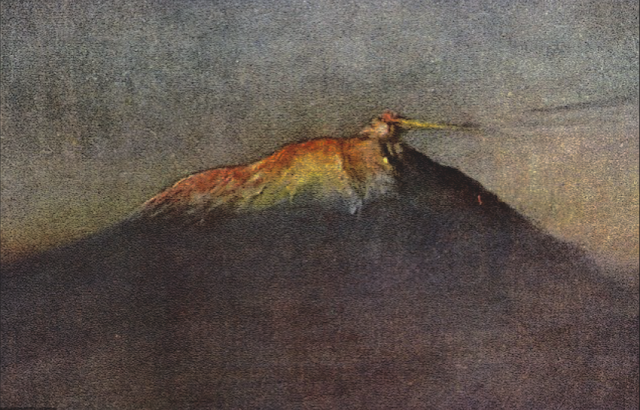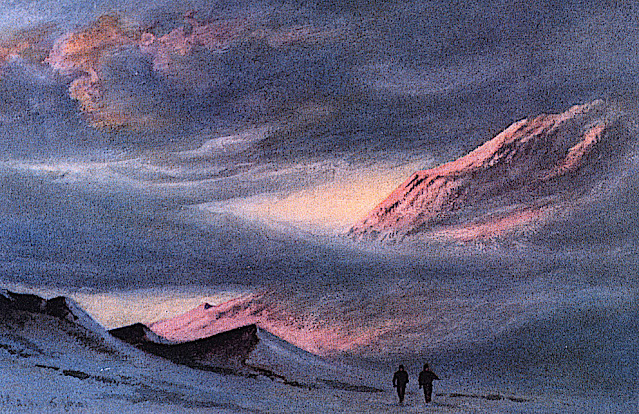Mont Kyffin (1, 670m -5, 480ft)
Antarctique (Nouvelle-Zélande)
L'artiste
Edward Adrian Wilson, surnommé « Oncle Bill » était un médecin anglais, explorateur polaire, historien naturel, peintre et ornithologue. Wilson a participé à deux expéditions britanniques en Antarctique, la Discovery Expedition (1901-1904) et la tragique expédition Terra Nova (1907-1912), toutes deux sous la direction de Scott.
Le Dr Edward A. Wilson est - considéré comme l’un des meilleurs artistes ayant jamais travaillé en Antarctique. Naviguant avec le capitaine Scott à bord du « Discovery » (1901-1904), il est devenu le dernier d'une longue tradition d'« artistes d'exploration » d'une époque où le crayon et l'aquarelle étaient les principales méthodes permettant de produire des enregistrements scientifiques précis de nouvelles terres et d'espèces animalières. Il a combiné des techniques scientifiques, topographiques et paysagères pour produire des images précises et magnifiques du dernier continent inconnu. La force de son œuvre fut telle qu’elle contribua également à fonder la tradition de la peinture animalière moderne. Wilson a notamment capturé sur papier l’essence du vol et du mouvement des oiseaux marins de l’océan Austral.
De retour avec le capitaine Scott à bord du « Terra Nova » (1910-1913) en tant que chef du personnel scientifique, il a continué à decrire le continent et sa faune avec une habileté extraordinaire. Choisi pour accompagner le capitaine Scott au pôle Sud, ses derniers dessins sont issus de l'un des voyages épiques les plus célèbres de l'histoire de l'exploration. Parallèlement à son travail scientifique, le crayon de Wilson a capturé la découverte de la tente de Roald Amundsen au pôle Sud par le capitaine Scott. Wilson mourut, avec les autres membres du British Pole Party, pendant le voyage de retour, en mars 1912. Les dessins et les peintures furent créés au prix d'un travail personnel considérable dans les conditions glaciales dans lesquelles Wilson travaillait. Il souffrait souvent gravement du froid lorsqu'il dessinait, ainsi que de la cécité des neiges ou de coups de soleil aux yeux. Ils constituent un remarquable témoignage de l’une des grandes figures de l’époque héroïque de l’exploration de l’Antarctique. Le livre a été produit en complément des « Carnets de la nature d'Edward Wilson » par deux des petits-neveux de Wilson, pour marquer le centenaire de sa mort.
La montagne
Le mont Kyffin (1, 670m -5, 480ft) est un relief brun rougeâtre avec un éperon en pente s'étendant sur4 milles marins au nord, à l'extrême nord de la chaîne du Commonwealth, se projetant du côté Est de Beardmore. Un glacier s'éleve précipitamment au-dessus de lui. Découvert par l'expédition antarctique britannique, 1907-1909 et nommé en l'honneur d'Evan Kyffin-Thomas, l'un des propriétaires du Register, compagnon de voyage de Shackleton lors du voyage depuis
l'Angleterre. La chaîne du Commonwealth est une chaîne de montagnes
escarpées orientées nord-sud, longue de 60 milles marins (110 km; 69
mi), située dans les montagnes Queen Maud sur la côte Dufek du continent
Antarctique.
_______________________________________
2011-2024 - Gravir les montagnes en peinture
Un blog de Francis Rousseau

-%20%20Mount-Patrick-%20Dec%2016th%201911.jpg)















